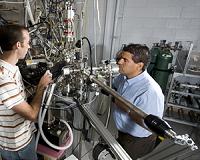 |
Washington DC (SPX) Nov 09, 2010 Physicists working on the National Spherical Torus Experiment (NSTX) at the Princeton Plasma Physics Laboratory are now one step closer to solving one of the grand challenges of magnetic fusion research-how to reduce the effect that the hot plasma has on fusion machine walls (or how to tame the plasma-material interface). Some heat from the hot plasma core of a fusion energy device escapes the plasma and can interact with reactor vessel walls. This not only erodes the walls and other components, but also contaminates the plasma-all challenges for practical fusion. One method to protect machine walls involves divertors, chambers outside the plasma into which the plasma heat exhaust (and impurities) flow. A new divertor concept, called the "snowflake," has been shown to significantly reduce the interaction between hot plasma and the cold walls surrounding it. Strong magnetic fields shape the hot plasma in the form of a donut in a magnetic fusion plasma reactor called a tokamak. As confined plasma particles move along magnetic field lines inside the tokamak, some particles and heat escape because of instabilities in the plasma. Surrounding the hot plasma is a colder plasma layer, the scrape-off layer, which forms the plasma-material interface. In this layer, escaped particles and heat flow along an "open" magnetic field line to a separate part of the vessel and enter a "divertor chamber." If the plasma striking the divertor surface is too hot, melting of the plasma-facing components and loss of coolant can occur. Under such undesirable conditions, the plasma-facing component lifetime would also be an issue, as they would tend to wear off too quickly. While the conventional magnetic X-point divertor concept has existed for three decades, a very recent theoretical idea and supporting calculations by Dr. D.D. Ryutov from Lawrence Livermore National Laboratory have indicated that a novel magnetic divertor-the "snowflake divertor"-would have much improved heat handling characteristics for the plasma-material interface. The name is derived from the appearance of magnetic field lines forming this novel magnetic interface. This magnetic configuration was recently realized in NSTX and fully confirmed the theoretical predictions. The snowflake divertor configuration was created by using only two or three existing magnetic coils. This achievement is an important result for future tokamak reactors that will operate with few magnetic coils. Because the snowflake divertor configuration flares the scrape-off layer at the divertor surface, the peak heat load is considerably reduced, as was confirmed by the divertor heat flux on NSTX. The plasma in the snowflake divertor, instead of heating the divertor surface on impact, radiated the heat away, cooled down and did not erode the plasma-facing components as much, thus extending their lifetime. Plasma TV images show more divertor radiation in the snowflake divertor plasmas in comparison with the standard plasmas. Importantly, the snowflake divertor did not have an impact on the high performance and confinement of the high-temperature core plasma, and even reduced the impurity contamination level of the main plasma. These highly encouraging results provide further support for the snowflake divertor as a viable plasma-material interface for future tokamak devices and for fusion development applications.
Share This Article With Planet Earth
Related Links American Physical Society Powering The World in the 21st Century at Energy-Daily.com
 Findings Show Promise For Nuclear Fusion Test Reactors
Findings Show Promise For Nuclear Fusion Test ReactorsWest Lafayette IN (SPX) Aug 02, 2010 Researchers have discovered mechanisms critical to interactions between hot plasma and surfaces facing the plasma inside a thermonuclear fusion reactor, part of work aimed at developing coatings capable of withstanding the grueling conditions inside the reactors. Fusion powers the stars and could lead to a limitless supply of clean energy. A fusion power plant would produce 10 times more e ... read more |
|
| The content herein, unless otherwise known to be public domain, are Copyright 1995-2010 - SpaceDaily. AFP and UPI Wire Stories are copyright Agence France-Presse and United Press International. ESA Portal Reports are copyright European Space Agency. All NASA sourced material is public domain. Additional copyrights may apply in whole or part to other bona fide parties. Advertising does not imply endorsement,agreement or approval of any opinions, statements or information provided by SpaceDaily on any Web page published or hosted by SpaceDaily. Privacy Statement |